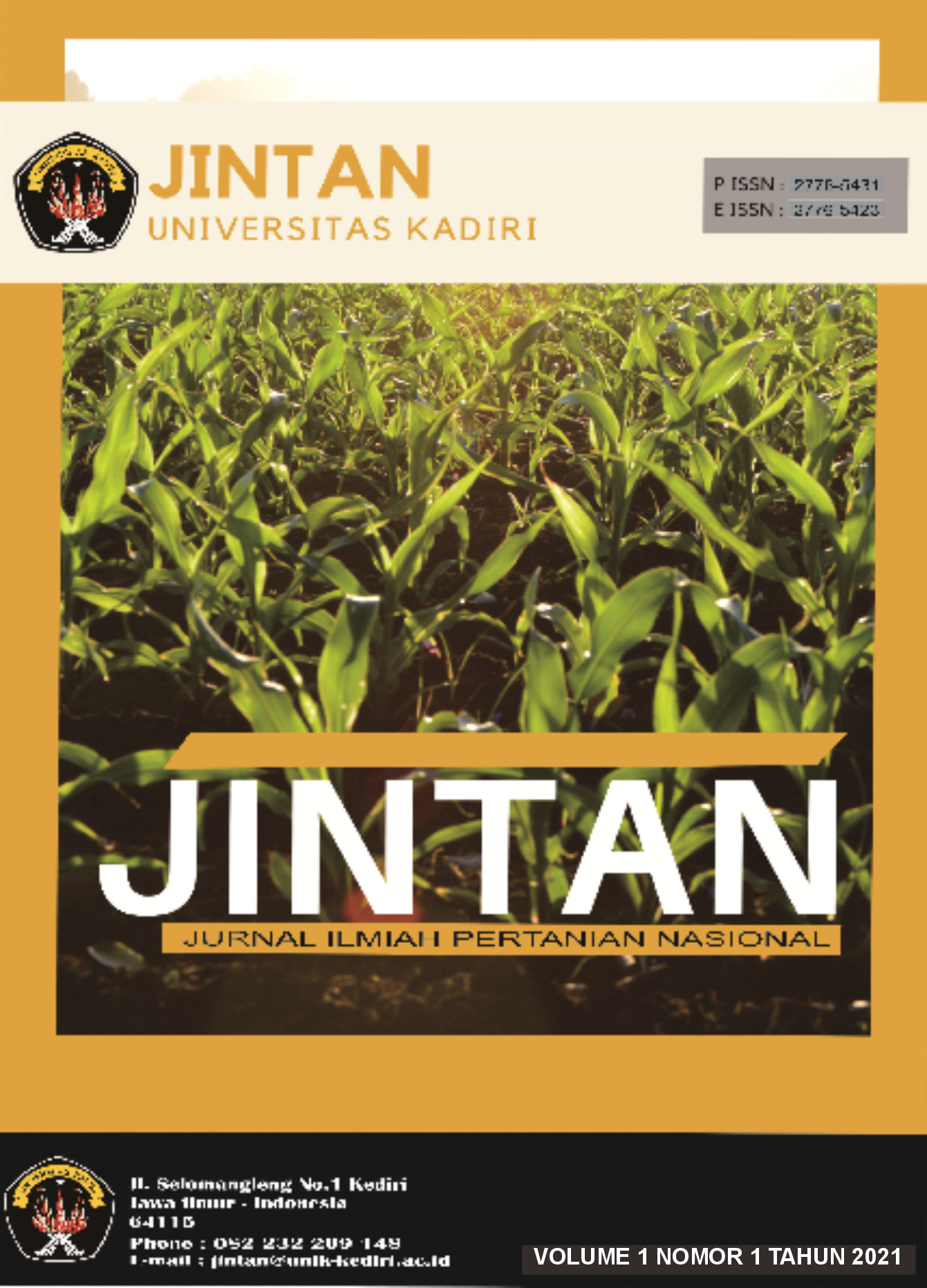Faktor – Faktor Eksternal yang Mempengaruhi Produksi Home Industri Tepung Tapioka
DOI:
https://doi.org/10.30737/jintan.v1i1.1387Kata Kunci:
External factors, Production, Tapioca flourAbstrak
The purpose of this research is to determine the external factors that affect tapioca flour production in the study area. Besides, this aimed to know the external factors that most influence the production of tapioca flour in the study area. To analyze the external factors that influence the home production of tapioca flour industry t-test and f-test analysis were used. The research results showed that the external factors of season, product demand, and fluctuations in raw material prices affected the production in home production of tapioca flour industry. The most influential external factor in tapioca flour production is the season factor, shown by the significant difference compared to other factors. Seasonal factors compared to product demand obtained the value of t-count 24.712 and t-table of 1.724. Season factors compared to fluctuations in raw material prices obtained t-count 34,899 and t-table 1,724, while product demand factors compared to fluctuations in raw material prices obtained t-count -1,840 and t- table 1,724.
Â
Tujuan penelitian ini adalah untuk mengetahui faktor eksternal yang mempengaruhi produksi tepung tapioka di daerah penelitian. Selain itu juga untuk mengetahui faktor eksternal yang paling berpengaruh terhadap produksi tepung tapioka di daerah penelitian. Untuk menganalis faktor-faktor eksternal yang mempengaruhi produksi Home industri tepung tapioka menggunakan analisis uji-t dan uji-f. Hasil penelitian yang didapat dari faktor-faktor eksternal yang mempengaruhi produksi Home industri tepung tapioka adalah faktor musim, permintaan produk dan fluktuasi harga bahan baku. Faktor eksternal yang paling berpengaruh dalam produksi tepung tapioka adalah musim, apabila dibandingkan dengan fluktuasi harga bahan baku diperoleh t-hitung sebesar -1,840 dan t-ditunjukkan dengan nilai beda nyata dibandingkan dengan faktor yang lain. Faktor musim dibandingkan dengan permintaan produk diperoleh nilai t-hitung 24,712 dan t-tabel 1,724. Faktor musim dibandingkan dengan fluktuasi harga bahan baku diperoleh t-hitung 34,899 dan t-tabel 1,724, sedangkan faktor permintaan produk dibandingkan fluktuasi harga bahan baku diperoleh t-hitung 1,840 dan t-tabel 1,724.
Referensi
Food Association Organization. 2015. Global information and early warning system on food and agriculture. Roma: FAO Press.
Gaustama Putra dan Alva Edy Tontowi. 2019. Analisis Ukuran Pori Biokomposit (Sericin-Bioplastik) Pada Berbagai Suhu Pembekuan Awal dengan Metode Taguchi. Jurnal Teknik Industri. 9(3): 145-153.
Kementerian Sekertariat Negara, 2014. Undang - Undang Nomor 3 Tentang Perindustrian. Jakarta: Kementerian Sekertariat Negara.
Mahir Pradana. 2018. Klasifikasi Bisnis E-Comerce di Indonesia. Jurnal Modus. 27(2): 163-174.
Mastuti Arum Dwi. (2017). Analisis Faktor - Faktor Yang Mempengaruhi Produksi Tepung Tapioka Pada Industri Skala Rumah Tangga di Kecamatan Nguntoronadi. Journal AGRISTA. 5(3): 289 - 301.
Oktiani, D. (2017). Pemodelan Harga dan Produksi Ubi Kayu Menggunakan Model Vektor Autoregressive (VAR). Jurnal Majalah Teknologi Agro Industri. 9(1): 7 - 15.
Pamujiati, A. D., dan Lisanty, N. (2020). Analisis Kelayakan Usaha Tiwul Instan di Kecamatan Bendungan Kabupaten Trenggalek. Jurnal Agrinika : Jurnal Agroteknologi dan Agribisnis. 4(1): 57-68. https://doi.org/10.30737/agrinika.v4 i1.798
Safitri Imroatul Amalia. (2016). Analisis Kelayakan Finansial dan Strategi Pengembangan Agroindustri Tepung Tapioka di Desa Pogalan Kecamatan Pogalan Kabupaten Trenggalek. Tesis. Fakultas Pertanian Universitas Jember.
Sermy Marjelina, Sri Endang Kornita dan Eka Armas Pailis. Analisis Faktor-faktor yang Mempengaruhi Produksi Industri Furnitur dari Alumunium di Kota Pekanbaru. Jom FEKON. 2(2): 1 - 8.
Sibarani Sako Sintya. (2015). Analisis Faktor-Faktor yang Mempengaruhi Produksi Industri Tapioka. Jurnal Jom FEKON. 2(2):1–14.
Sugiyono. 2018. Metode Penelitian Kuantitatif, Kualitatif, R&D. Bandung: Alfabeta Press.
Unduhan
Diterbitkan
Cara Mengutip
Terbitan
Bagian
Lisensi
Authors who publish in this journal agree to the following terms:
- Authors retain copyright and grant the journal right of first publication with the work simultaneously licensed under a Creative Commons Attribution License (https://creativecommons.org/licenses/by-nc-nd/4.0/) that allows others to share the work with an acknowledgment of the work's authorship and initial publication in this journal. Permitted third party reuse is defined by the Creative Commons Attribution-NonCommercial-NoDerivs (CC BY-NC-ND). This permission allows users to copy and distribute the Article, provided this is not done for commercial purposes and further does not permit distribution of the Article if it is changed or edited in any way, and provided the user gives appropriate credit (with a link to the formal publication through the relevant DOI), provides a link to the license, and that the licensor is not represented as endorsing the use made of the work.
- Authors are able to enter into separate, additional contractual arrangements for the non-exclusive distribution of the journal's published version of the work (e.g., post it to an institutional repository or publish it in a book), with an acknowledgment of its initial publication in this journal.
- Authors are permitted and encouraged to post their work online (e.g., in institutional repositories or on their website) prior to and during the submission process, as it can lead to productive exchanges, as well as earlier and greater citation of published work.
- For open-access publishing, authors have the right to share their articles in the same ways permitted to third parties under the relevant user license, as well as certain scholarly usage rights.




